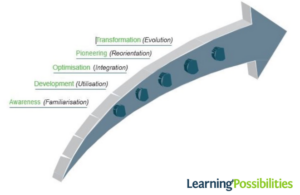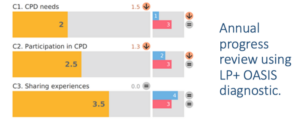Reflections on the success of HWB+ Wales
Learning Possibilities in Wales – a world-class EdTech intervention promoting hybrid learning
As the school gates start reopening in the wake of the pandemic-induced closures, it is a good time to reflect on the lessons learned during the shift to online learning during these traumatic times.
When schools and governments begin reflecting, at a system level, on how to build resilience into the learning framework, two of the main takeaways from those schools that were best able to meet the learning needs of the whole school community during their forced closures are:
- Digital skills amongst the teaching workforce can no longer be confined to those who are skilful early adopters of the new technologies, but ALL teachers now need to have, at their fingertips, the skills and capacity to be able to operate hybrid learning online learning environments
- Students should be better prepared for a future that involves more home study and learning online through the development of their repertoire of skills and competencies in self-directed learning
The implementation of national learning platform in Wales, which Learning Possibilities installed and rolled out to more than 700,000 users, has been held out as a model of international best practice. In the study conducted by NESTA[1] in the UK, in collaboration with its international counterpart in Italy, the Welsh Government’s Strategy on Digital Competency in Wales, for which Learning Possibilities provided both the learning platform and the professional development and training framework, was singled out as one of only nine examples of best practice across the world.

The ‘Digital Competence Framework’ established digital competence as one of three cross-curricular responsibilities, alongside literacy and numeracy. The framework focuses on developing a broad set of digital skills required in our increasingly digital world. These span four main strands: citizenship, interacting and collaborating, producing; data and computational thinking.
Critical to the success of the project was the creation of learning platform, Hwb+, and the promotion of its use through the creation of ‘Digital Pioneer Schools’ which enabled the creation of a network for shared learning between schools and government, and also between Digital Pioneer Schools and other schools across Wales . The schools involved early in the programme acted as hubs for sharing learning, sometimes offering training for teachers from other schools facilitated via their Consortia. The school and teacher-led approach meant that through the Digital Pioneer Schools network, the government involved schools in the development process. This helped to gain buy-in from schools, while also stress-testing the framework in real settings. Another critical success factor was the creation of pairing and mentoring schemes. For example, one school supported the roll-out of Hwb+ in every classroom by ensuring that reluctant teachers were always paired with a more confident teacher. Additionally, student digital leadership schemes were set up in many schools, where students were given responsibility to support teachers and other peers with ICT issues and champion digital learning. Such schemes are reported to be effective in supporting teachers with IT frustrations, encouraging more teachers to use IT as well as developing leadership and communication skills in participating pupils.

The ADOPT professional development framework from Learning Possibilities, was the implementation tool that was used in schools nationally as a roadmap to guide the journey from early familiarisation with the technology tools and resources available on Hwb+ learning platform and the steps towards transformation: where learning and teaching, in the new paradigm, fully embraces an integration of face-to-face and online learning in a truly hybrid manifestation.

The resources to support the ADOPT framework are constantly being reviewed and improved by the technical team at Learning Possibilities and the framework has now been integrated with the LP-OASIS, online testing and evaluation system to produce annual progress reports charting the professional development of staff and informing the next stage of school development planning .
[1] National Endowment for Science Technology and the Arts

